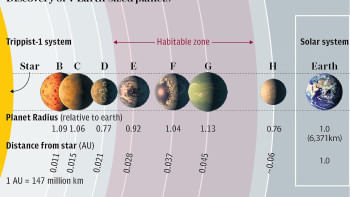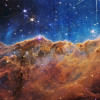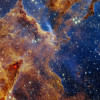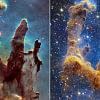Answer to the origin of life on Earth may be in a distant star

The origin of life is the classic chicken-and-egg conundrum, although it is well-known that carbon-based compounds are the main components of all forms of life. For example, out of a host of complex organic compounds, two that are essential for living organisms are uracil and niacin. Made up of carbon, hydrogen, nitrogen and oxygen, uracil is one of the constituents of RNA, which contains the blueprint of life, while niacin (Vitamin B3) controls the cholesterol and triglyceride levels. Hence, scientists working to understand the origin of life on Earth are particularly interested in compounds containing carbon.
Our planet was born about 4.55 billion years ago, but life might have had a difficult time during the first several hundred million years of Earth's history. This was the time of heavy bombardment, when Earth was struck repeatedly by large comets and asteroids. Studies of craters on the Moon suggest that the last major impacts of the heavy bombardment occurred between about 4.2 and 3.9 billion years ago. A few of these bombardments had sufficient energy to wipe out any life that might already have been present on Earth.
So, how did life arise on Earth? The unifying theory through which we understand the history of life on this planet is the theory of evolution, proposed by Charles Darwin. Before the publication of his On the Origin of Species in 1859, the widely held view of life was that it arose spontaneously from non-living matter. Darwin essentially debunked such an idea by showing how species develop gradually as a result of environmental pressures. But he made no attempt to explain how life came into being on a once lifeless Earth.
In 1907, Swedish chemist and Nobel Laureate Svante Arrhenius suggested that life on Earth was introduced billions of years ago from outer space, originally in the form of microscopic spores that float through the cosmos, landing here and there to act as seeds for new biological systems. This idea, called the Panspermia hypothesis, can be traced back to Anaxagoras, the Greek philosopher who lived in the fifth century BC. He claimed that the Universe is made of an infinite number of spermata, or seeds, which gave rise to life forms on reaching the Earth.
The idea that life could travel through space to land on Earth once seemed outlandish. After all, it is hard to imagine a more foreboding environment than that of space, with no air, no water, and constant bombardment by dangerous radiation from the stars. However, the presence of a rich array of carbon compounds in comets, asteroids and meteors tells us that the building blocks of life can survive in space, and tests have shown that some microbes can survive in space for years.
Although methyl cation does not react efficiently with hydrogen, the most abundant element in the Universe, it reacts readily with a wide range of other molecules, and therefore initiates the production of more complex carbon-based molecules that make up life as we know it. That is why this molecule, never before seen in space, is believed to be a cornerstone for studying the origin of life on Earth.
Thus, the Panspermia hypothesis may not be an improbable idea. Analysis of Hale-Bopp, the comet that lit up the night sky for the better part of 1995-1997, clearly revealed that the chemicals that evaporated from its nucleus – a ball of ice a few kilometres in diameter – were not just tonnes of water, but a frozen "primordial soup" of many organic materials that are the basic ingredients of life. These materials were also found in Halley's Comet by Giotto, a robotic spacecraft of the European Space Agency, as it flew by and studied its composition in March 1986.
These two comets together with the Comet Hyakutake that made its closest approach to Earth in March 1996 led researchers to conclude that life-forming material may not have been produced on Earth. Instead, they were brought here by heavenly objects when they bombarded the nascent Earth. Indeed, the earliest evidence for life on Earth suggests it was present some 3.83 billion years ago, overlapping with the bombardment period.
Furthermore, in 2019, scientists detected uracil and niacin in rocks obtained by the Japanese Space Agency's Hayabusa2 spacecraft from Ryugu, a carbon-rich asteroid that was formed in the cloud of gas and dust that created our solar system. This study also supports the hypothesis that pounding by comets, as well as asteroids and meteorites, seeded our young planet with compounds that paved the way for the first microorganisms.
And now, Nasa's James Webb Space Telescope (JWST) swung into action. In an article published last month in the journal Nature, a team of international scientists reports that JWST has detected a carbon compound called methyl cation (CH3+) for the first time in space in a star system, a small red dwarf about one-tenth the size of the Sun, roughly 1,350 light years away in the Orion Nebula. This discovery clearly shows that unlike Hubble or other space-based telescopes, JWST is not only capable of resolving smaller details in galaxies, stars and nebulae, but it can also pick out the signatures of specific molecules with great precision.
Although methyl cation does not react efficiently with hydrogen, the most abundant element in the Universe, it reacts readily with a wide range of other molecules, and therefore initiates the production of more complex carbon-based molecules that make up life as we know it. That is why this molecule, never before seen in space, is believed to be a cornerstone for studying the origin of life on Earth.
Interestingly, while ultraviolet radiation from nearby stars might degrade some organic compounds, researchers think it is also supplying the energy needed for methyl cation to form in the first place, and perhaps played a crucial role in the early stages of the origins of life.
In sum, discovery of methyl cation by JWST in a young star in the Orion Nebula lends credence to the Panspermia hypothesis that heavenly vans, such as comets, transporting tonnes of carbon-rich materials from interstellar space may have been the genesis of life on Earth. However, this does not preclude the hypothesis that we are simply highly evolved primates that progressively turned into modern, upright humans.
Dr Quamrul Haider is a professor of physics at Fordham University in New York, US.

 For all latest news, follow The Daily Star's Google News channel.
For all latest news, follow The Daily Star's Google News channel. 










Comments